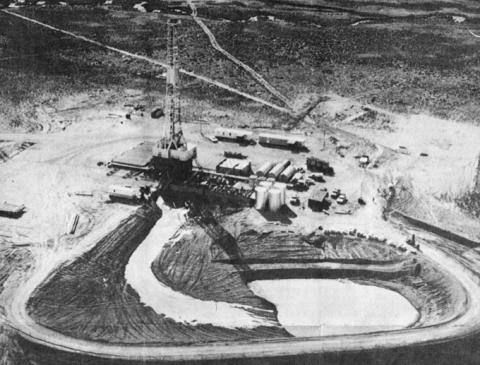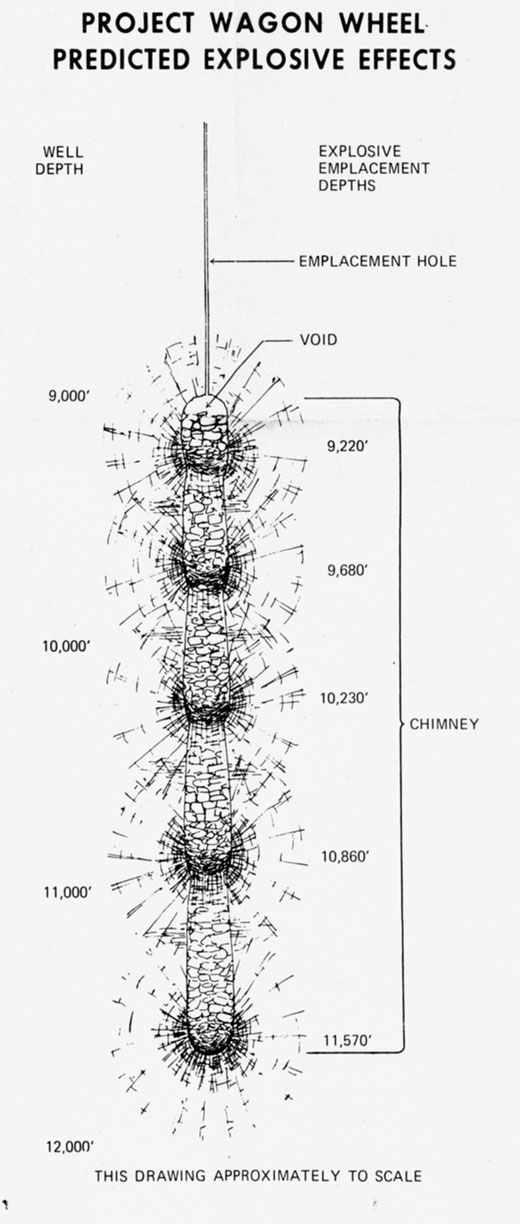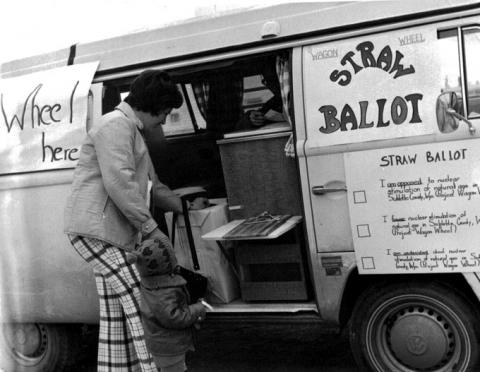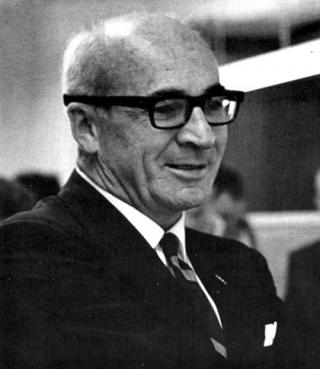- Home
- Encyclopedia
- The Wagon Wheel Project
The Wagon Wheel Project
A late-1960s Atomic Energy Commission plan to extract Wyoming natural gas with five underground nuclear explosions won strong initial support from the oil and gas industry and the federal government. Finally, however, the idea stalled, thanks to the emergence of more information on possible dangers, to Washington politics, and especially to intense local opposition in Sublette County, Wyo., where the devices were slated to be detonated.

California Oil Company, later named Chevron, first drilled on the Pinedale Anticline, in Sublette County, in 1939 using rotary tools, state-of-the-art drilling equipment at the time. After drilling 10,000 feet, they found very little of what they were after – oil. They did, however, find plenty of natural gas. But there was no market for it and the company plugged the well and abandoned the site.
El Paso Gas Company, of El Paso, Texas, purchased the well but with hopes to drill for gas. In the late 1940s and early 1950s, El Paso drilled seven wells in the area; all producing only limited amounts gas. Technology was not yet developed to extract the gas trapped in tight sandstone layers more than 7,500 feet below the surface, and the venture was deemed a failure.
El Paso remained in the area, however, continuing to research ways to retrieve the gas from the earth. One method involved pumping fresh water into the well. This caused the clay in the earth to swell, however, further tightening the formation and making the gas even more difficult to extract. In 1958, El Paso proposed to the U.S. Atomic Energy Commission (AEC) that the problem be solved by using nuclear devices to assist with obtaining natural gas in the area around Pinedale, Wyo. in Sublette County.
El Paso’s project became part of a joint effort between private industry and the United States Government as part of the Atomic Energy Commission’s Plowshare Program, a project after World War II to help the United States develop nuclear energy for peaceful uses. By the early 1960s, the AEC had approved four nuclear detonations around the West to help extract natural gas.
The first explosion was detonated December 10, 1967 near Farmington in northwestern New Mexico. Operation Gasbuggy, as it was called, was a joint effort of the AEC, the U.S. Department of the Interior and El Paso Natural Gas. The detonation of the 29-kiloton device took place 4,240 feet below the surface and created a “chimney” of rubbled rock about 160 feet in diameter and about 330 feet tall. (One kiloton is equivalent to a blast yield of 1,000 tons of TNT. By comparison, the bomb dropped by the U.S. Army Air Force on Hiroshima, Japan in 1945 yielded around 15 kilotons of explosive power; the one dropped on Nagasaki yielded around 21 kilotons.)
A month after the detonation, a well was drilled into the chimney and natural gas was withdrawn. More than 200 million cubic feet of gas was extracted in a little over a year, and all of it was flared, or burned, at the site. This detonation was only intended as an experiment to determine how effective the explosion was in stimulating a reservoir of natural gas. The gas company determined it was successful.
A second nuclear device, this time 40 kilotons, was tested on September 10, 1969, near Rulison, Colorado. Unlike Project Gasbuggy, which experienced little local resistance and a great deal of support, especially from the state’s political leaders, the Rulison explosion had considerable public opposition. Despite public protest and lawsuits filed by environmental groups to stop the nuclear detonation, Project Rulison was set off at Rifle, Colorado, below 73-year-old Claude Hayward’s 292-acre potato patch. The gas company made gestures for compensation to Mr. Hayward, but payments were never made.
A third nuclear experiment, Project Rio Blanco, also near Rifle, was detonated in May 1973. This project set off three separate 30-kiloton devices simultaneously at depths ranging from 5,838 to 6,690 feet in the same bore hole.
In those same years, another experimental site was being explored. In 1968, El Paso signed a contract with the AEC to study the feasibility of exploding a nuclear device 19 miles south-southeast of Pinedale, 18 miles east-northeast of Big Piney and Marbleton, Wyo., and 10 miles south of Boulder, Wyo. on Bureau of Land Management property leased to the company. Known as Project Wagon Wheel, it, like Operation Gasbuggy, was designed as an experiment to study the effectiveness of nuclear power to extract natural gas. El Paso estimated the sandstone in this area contained 300 trillion cubic feet of natural gas at depths between 10,000 and 18,000 feet.
“Pinedale Area May Become Nation’s Natural Gas Center” the Pinedale Roundup headline trumpeted in January 1968. “The Pinedale area may become the site of one of the nation’s first endeavors to produce marketable natural gas through an underground nuclear blast, Congressman Harrison informed us today.” This was Republican Wyoming Congressman William Henry Harrison, who by that time had served six terms in Congress over the previous 18 years. The congressman’s announcement may have been good news for many in oil and gas, but the project Harrison was talking about eventually sparked the most controversial event in the area’s history.
In May 1969, the Pinedale Roundup reported El Paso Gas Company was maintaining that “safety of our water, our area, and our people is the first consideration of all involved.” Company officials went on to explain the technical aspects of the nuclear test and the safety precautions, and further asked local citizens for their cooperation and “willingness to go along with the project.” At about the same time of the announcement, the company was drilling an exploratory hole at the study site for the production tests.

In January 1972, the AEC published the draft Environmental Statement, “Wagon Wheel Gas Stimulation Project.” Copies were made available to the public at the Pinedale and Big Piney libraries, and were quickly checked out and read by many local citizens. The overwhelming response was wide consternation.
In the draft EIS, El Paso Natural revealed that the initial experiment would involve five 100-kiloton devices detonated sequentially underground, a few minutes apart, in a single well at depths ranging from 9,220 feet to 11,570 feet. Despite the previous experimental detonations using atomic devices to extract natural gas, resistance mounted on many levels.
Sublette County residents began to worry publicly about the likely effects of the explosions and fallout on vegetation, wildlife and livestock, and on bridges, roads, reservoirs and concrete irrigation canals. Local residents formed the Wagon Wheel Information Committee (WWIC) to educate themselves about the proposed atomic test in Sublette County. This group consisted of local ranchers, housewives, business and professional men and women, teachers and students.
A more global concern was the timing of the explosions. The AEC had not yet perfected the technology to detonate the devices sequentially. Yet, they needed to be exploded in sequence rather than simultaneously for the U.S. government to comply with the 1963 Limited Test Ban Treaty and the soon-to-be signed Threshold Test Ban Treaty, which forbade countries from testing bombs larger than 150 kilotons. Wagon Wheel’s yield would have been a total of 500 kilotons, but could maintain technical compliance with the treaty if detonated as five separate, 100-kiloton explosions.
According to the AEC, three billion cubic feet of radioactive gas would be released and flared—burned off—during the test, leaving radioactive tritium, krypton-85, and argon-37 in the local atmosphere. These unavoidable radiation levels would be very low and of no danger to humans, the agency maintained.
Locals were particularly displeased to read in the Pinedale Roundup in February 1972 that it was possible to store the gas, rather than flaring it—but that to store it would double El Paso’s costs, the company claimed. Therefore, El Paso preferred to risk the fallout danger and flare the gas locally.
The draft environmental report failed to address other issues of local concern, such as the impact on domestic animals, on wildlife and on feed for these animals in the area surrounding the test site. Locals educated themselves about the possibility of tritium poisoning, which they would get from cows that ingested radiation-contaminated grass. The tritium would build up in the cows’ milk and meat. All the local cattle, then, would need uncontaminated feed brought in from elsewhere. There was no mention of payment for this feed to be brought into Sublette County.
Furthermore, no space was given to contamination of deer, moose, antelope, elk, and fish. In response, the Wyoming Game and Fish Commission released a scathing comment regarding the inadequacies of the draft EIS on fish and wildlife. “Sections of the statement,” the Wyoming Game and Fish Commission explained in a March 9 letter, “which relate to fish and wildlife are wholly inadequate and clearly reflect the absence of wildlife and ecological expertise on the evaluation staff. … [T]he impact on fish and wildlife and the economics of these resources had been grossly understated.”
In March 1972, the WWIC convened a public discussion about the Wagon Wheel Project at Pinedale High School. The meeting, sponsored in conjunction with the Sublette County Commissioners, was open to all residents of the county and the surrounding communities. More than 600 people came to hear the panel of state, county and local officials. People from Sublette, Sweetwater and Teton counties came, as did concerned citizens from Colorado and other nearby states. No one from AEC or El Paso Company was on hand.
A week later, the WWIC published its official comments on the draft EIS and sent them to the AEC, which had stated that comments would be welcomed and considered. The WWIC comments, however, were never officially answered nor included in the Final Environmental Statement that was released in September 1972. Wyoming’s Democratic senator, Gale McGee, told the Casper Star-Tribune that the report “was premature” and “failed to cover the overall impact.”
AEC and El Paso representatives finally went before the public in late April, at a meeting convened by the Wyoming Wildlife Federation and the Green River Valley Cattlemen’s Association. The meeting ran five hours and again, attendance was high. Phillip Randolph of El Paso told the crowd there was “little potential danger” in the plan.
There were some supporters in Sublette County for Project Wagon Wheel. Donald R. Wassenberg, for example, president of the State Bank of Big Piney, wrote, “In view of the energy crisis facing this nation, I do not believe that we can afford to overlook any possibility of increasing our supply and extending our known reserve of natural gas. Further I feel that the completion of this project will provide a badly needed boost for the lagging economy in Sublette County. It is my opinion that the Atomic Energy Commission has performed enough tests and made enough studies that the risk, if any, is minimal, and is far outweighed by the benefits to be derived to the nation and to the local economy.”
Throughout 1972, concern for the Wagon Wheel project expanded beyond Sublette County. Through the efforts of the Wagon Wheel Information Committee, publicity was picked up in newspapers throughout Wyoming and adjoining states, and even reached The Des Moines Register, The Los Angeles Times, and The Nation Magazine. These articles reflected far more sympathy for the local committee than for the gas company and the AEC. Opposition focused on groundwater, fish and wildlife, costs to taxpayers, need for alternative energy sources, seismic activity and lack of public hearings. Wyoming Governor Stan Hathaway favored the proposal, but as public opposition mounted throughout 1972, the governor lessened his public support somewhat and called for more study and information about the atomic test.

Local opposition continued to mount. Sublette County citizens had been assured several times by El Paso Gas that if they did not want the project to come to fruition, it would not. Taking the company at its word, the WWIC decided the best way to prove or disprove local support for the Wagon Wheel Project was through a vote of the citizens. Because Wyoming statutes prohibit votes on public policy, this issue could not be put on an official ballot. Members of WWIC, therefore, opted to conduct an unofficial “straw poll,” on Nov. 7, 1972, the day of the presidential election.
The results of the unofficial referendum were overwhelmingly against the Project Wagon Wheel, with 970 opposed, 279 in favor, and 105 undecided. Ballots were collected by the Sublette County Sheriff’s Department, and counted by four local ministers. A majority—78 percent—of the citizens who voted in the general election also participated in the WWIC straw election.
At a press conference in Cheyenne in December, Randolph of El Paso was asked about the straw vote. He responded by stating that he felt the vote was “premature” because the company had never decided to do the project, but had only considered doing so. At this news conference, Randolph was asked what the 19,000-foot hole was doing out there, if the project didn’t exist. Furthermore, what non-project had El Paso Natural Gas Company and AEC spent $8 million and issued two environmental impact statements for?
Meanwhile, the WWIC on December 8, 1972, wrote to U.S. Sen. Cliff Hansen, formally requesting him to set up a meeting in Washington, D.C. with AEC Director Dr. James R. Schlesinger. The meeting was arranged for February 1973 and included other officials involved with Project Wagon Wheel.
Ten community citizens traveled to Washington D.C. in the quest to get Project Wagon Wheel cancelled. They soon learned that Schlesinger refused to come to a meeting. The delegates met with Environmental Protection Agency officials and staff scientists. They also met with representatives at the Department of the Interior, who had permitted the site for the detonation, and were told the BLM could not stop the project. Members also sat down with Bill Dirks, an official with the President’s Council on Environmental Quality. While in Washington, D.C., WWIC Chairman and Boulder rancher Floyd Bousman appeared on the “Today Show” opposite Philip Randolph of El Paso to discuss the Wagon Wheel Project.

At the same time that winter, the project ran into opposition on both sides of the aisle in Congress. Wyoming’s lone congressman, Democrat Teno Roncalio, was appointed to Congress’s Joint Committee on Atomic Energy, where he worked steadily, and often with economic arguments, to de-fund the Plowshare Program. (Those arguments were not hard to make. The Rulison Project, for example, had produced $1.4 million worth of natural gas but cost the ACEC $11 million, the High Country News reported in March 1973.) And Hansen, in the Senate, noted that President Nixon’s budget provided no funds for Project Wagon Wheel until 1977 at the earliest.
In 1974, the test well that El Paso Natural Gas had drilled for Wagon Wheel was used instead for an attempt at what then was called massive hydraulic fracturing, to crack open the gas-bearing rock by pumping large amounts of water under pressure down the well. The procedure didn’t work and the hole was eventually plugged and never reopened.
WWIC’s efforts, therefore, were ultimately successful. A nuclear detonation never occurred in Sublette County. Project Wagon Wheel was never cancelled; it just was never funded. Because the project was not cancelled, the WWIC did not disband until 2006.
Hydraulic fracturing, done now with a combination of water and other chemicals, is routine today, and has made the Pinedale Anticline and the Jonah Field near Pinedale one of the most productive gas fields in the world. And all without exploding a single atomic device.
Resources
Primary Sources
- Committee on Interior and Insular Affairs, “Nuclear Stimulation of Natural Gas.” Hearing Before the Subcommittee on Public Lands of the Committee on Interior and Insular Affairs, United States Senate, Ninety-Third Congress, First Session, May 11, 1973.
- United States Atomic Energy Commission, Draft Environmental Statement, “Wagon Wheel Gas Stimulation Project, Sublette County, Wyoming.” January 1972.
- The Wagon Wheel Project was covered widely in Wyoming newspapers, especially the Pinedale Roundup. Highlights, listed chronologically for convenience, include:
- "Pinedale Area Has Over $650 Million Stored Gas." Pinedale Roundup, Oct. 26, 1967.
- “Pinedale Area May Become Nation’s Natural Gas Center.” Pinedale Roundup, Jan. 4, 1968.
- "Two Nuclear Stimulation Meetings To Be Held in County." Pinedale Roundup; May 15, 1969.
- "Nuclear Detonation Plans Put Safety at Top of List." Pinedale Roundup; May 22, 1969.
- “Wagon Wheel Blast Set for Fall of 1973.” Pinedale Roundup; Feb. 3, 1972.
- “Participants ‘Take a Look’.” Pinedale Roundup, March 2, 1972.
- “Dr. Philip Randolph’s Talk at Big Piney.” Pinedale Roundup, May 4, 1972,
- "County Voters Showed Much Interest in Straw Vote on the Wagon Wheel Project." Pinedale Roundup, Nov. 9, 1972.
- “EPNG Has Burden Of WW Proof: Roncalio.” Rock Springs Rocket-Miner, Dec. 7, 1972.
- “Wagon Wheel Opposition Seeks Meeting with AEC.” Casper Star-Tribune, Dec. 12, 1972.
- "Bousman 'Looked Good' on TV Show." Pinedale Roundup, Feb. 8, 1973.
- “Wagon Wheel Doomed: Teno.” Casper Star-Tribune, April 1, 1973.
Secondary Sources
- Lederer, Adam. “Project Wagon Wheel: A Nuclear Plowshare for Wyoming.” Phil Roberts, ed., Readings in Wyoming History, 4th Edition. Laramie, Wyo.: Skyline West Press, 2004. Lederer’s article was first published in the summer 1998 issue of Annals of Wyoming, and was adapted from his 1998 University of Wyoming master’s thesis, Using Public Policy Models to Evaluate Nuclear Stimulation Projects: Wagon Wheel in Wyoming.
- Noble, Ann Chambers. “The Jonah Field and Pinedale Anticline: A Natural Gas Success Story.” WyoHistory.org, accessed 2/17/12 at /essays/jonah-field-and-pinedale-anticline-natural-gas-success-story.
- Noble, Ann Chambers. “The Wagon Wheel Information Committee,” Pinedale, Wyoming: A Centennial History 1904 – 2004. Pinedale, Wyo.: Sublette County Historical Society, 2005, 228 – 247.
- Steele, Mary Ann, “Summary of WWIC Efforts Which Prevented The Wagon Wheel Project From Being Detonated.” Unpublished. American Heritage Center Collection, University of Wyoming, Laramie.
- “Threshold Test Ban Treaty.” atomicarchive.com, accessed 2/17/12 at http://www.atomicarchive.com/Treaties/Treaty10.shtml.
Illustrations
- The photo of the Wagon Wheel test well ran May 8, 1972 in the Casper Star-Tribune. It and the diagram of the proposed placements of the nuclear devices in the Wagon Wheel test well are in the collection of the Casper College Western History Center. Used with thanks.
- The photo Mary Skinner voting in the Wagon Wheel straw poll, by Sally Mackey, and the photo of Rep. Teno Roncalio, D-Wyo. by his son, Frank Roncalio, are from pp. 228 and 238 of Pinedale, Wyoming: A Centennial History 1904 – 2004, by Ann Noble, cited above. Used with thanks to the photographers and the author.
